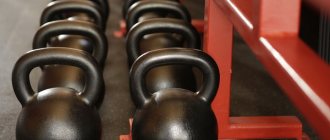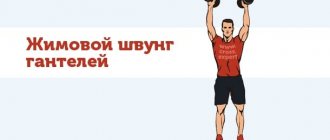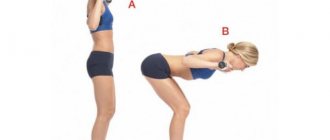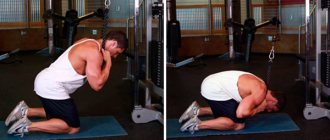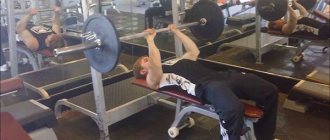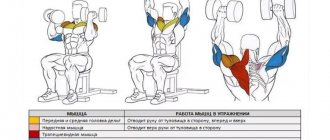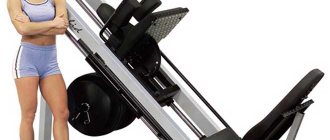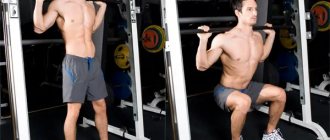Benefits of the Kettlebell Snatch
- Increases the strength of muscles and ligaments.
- Develops speed endurance, as well as general endurance of the body.
- Improves the cardiorespiratory system by accelerating the heart rate and absorbing large amounts of oxygen.
- Improves grip, joint mobility, elasticity of muscles and ligaments.
- The exercise not only develops muscle volume, but also, due to the high intensity of execution, can burn subcutaneous fat.
Important! Proper breathing plays a huge role in the snatch. Under no circumstances should you hold your breath, otherwise the body will not have enough oxygen to perform the exercise efficiently and safely.
At the fixation point, you can perform several breathing cycles (inhale-exhale) if you need to restore strength.
Kettlebell snatch and jerk: how to breathe correctly?
Many novice athletes do not think about the need to breathe properly. Training with weights quickly causes oxygen starvation in the body. Errors in breathing lead to insufficient oxygen supply to the body, as a result, the muscles will quickly tire. Kettlebell lifting involves exhaling when applying force and exhaling at the stage of muscle relaxation.
When performing exercises with weights, it is recommended to adhere to breathing, consisting of 3 cycles:
- inhale when lifting the projectile and exhale when detonating;
- inhale when performing a squat and exhale when straightening the body and arms;
- inhale when the weight reaches chest level when lowering, exhale until the swing.
Where to start for a beginner
Before starting a workout, you need to thoroughly warm up your muscles and joints . Be sure to stretch your muscles before and after exercise. Stretching will allow the muscles to remain flexible and elastic, which will further prevent injuries such as sprains and tears.
It is necessary to develop grip strength so that the hands do not get injured during jerking movements or even slow down progress in the exercise due to weakness of the ligamentous apparatus. Train your forearm along with your major muscle groups. Perform basic multifunctional exercises to develop strength not only in muscles, but also in ligaments.
To begin, practice snatches with light weights. Don't do the exercise for a while. Poor technique at high speed will not develop accuracy of movements, and in the future increasing the weight of the kettlebell will be impossible and very dangerous.
Work on your technique in the presence of a professional. Only after honing the correct movements, start working on speed, that is, a large number of repetitions in a short period of time.
Snatch training and technique
The kettlebell snatch is a technically challenging exercise. Conventionally, it is divided into several components, the correct implementation of which guarantees a greater number of lifts in 1 approach. As a rule, in competitions 10 minutes are allotted to perform the exercise. During this time, you need to make the maximum number of jerks with both hands. Their total number is divided by two - the resulting number is points. Proper snatching at the very beginning can save the lion's share of the energy required for the exercise.
In order to correctly carry out a jerk, you need to take the starting position, feet shoulder-width apart, the weight is at a distance of 15 - 20 cm from the toe of the foot. Then you need to sit down, keeping your back straight, not bent. Arm of a weight
, grab only from above. The thumb should wrap around the index and middle fingers of the hand. The jerk itself must be done using the muscles of the legs and back. The first stage of the jerk is a squat, grabbing the handle of the weight, after lifting the weight off the platform, swinging the weight back (between the legs) and then bringing it to the front position. It is worth paying attention to the fact that at this time the hand should be in a straight position.
When bringing the projectile to the forward position
, the pelvic muscles of the legs and back actively work, and with further detonation of the projectile upward, the latissimus dorsi and delta muscles are activated. Throughout the exercise, the forearms are constantly working. It is important to know that the back, during the jerk, does not linger in a vertical position, but leans back slightly; at the same time, a light squat is performed to evenly distribute the load. The second hand is in a free position and does not touch the thigh.
A common beginner mistake is to start the snatch when it is at the level of the knees when brought to the front position. This method is uneconomical in terms of energy consumption; accordingly, the athlete performs fewer jerks with one hand at a time. The optimal moment of the jerk is for the athlete to position the weight at an angle of 45 degrees forward.
Another stage in detonating a projectile is changing the position of the hand in the arch of the weight when it is in a vertical position. After moving the arm with the weight back, at the moment the projectile is brought to the front position, a muscle push occurs, giving a certain degree of acceleration to the jerk.
At the moment when the hand with the weight has assumed a vertical position, the athlete’s task is to correctly change the position of the hand in the arch of the apparatus - not too early, but not too late, since this is fraught with unnecessary force of the weight. In this case, the shoulder girdle will be heavily loaded, and this is also not economical in terms of energy consumption. When the position of the hand in the arch of the projectile is changed correctly, the hand smoothly stops in a vertical position.
In order for the jerk to be marked as completed, you need to ensure that your arm is fixed in a vertical position. But there is another point
: While fixing the weights in a vertical position, it is possible to try to relax the muscles and rest.
Resetting the projectile for a second jerk is carried out by squatting slightly and bending the back back. This reduces the height of the load falling. And the second push is much easier.
Performing a two-handed snatch
The technique of performing the exercise is practically no different from the traditional kettlebell snatch. Except that the position of the hands in the arch of the kettlebell does not change in a vertical position. Otherwise, the technique is the same. It is also recommended to start training with light weights in order to eliminate the possibility of injuries and sprains.
Snatch of two weights at the same time
The technique of snatching two weights at the same time has some differences from the classical one. Indeed, in this case there are 2 weights, which means removing two projectiles will require a wider stance of the legs. Special control over the center of gravity and breathing is also important. This exercise is mainly used in cross-fit complexes, as it increases strength and endurance. As with all weight training exercises, you should start training the 2 kettlebell snatch at the same time with light weights. Otherwise, the benefits of the exercise will be less than the harm.
Correct breathing
Proper breathing plays the most important role in kettlebell lifting. There are several techniques that have been used successfully. But three-stage breathing is considered the most effective. As you inhale, it is recommended to lift the weight off the floor or platform, and as you exhale, complete the lift. When moving the weight back and squatting, you need to inhale, and while exhaling, you need to align the body and fix the weight. As you inhale, you release the weight to the chest level, and as you exhale, you need to complete the release of the weight and prepare for the second swing.
As in other sports, kettlebell competitions have their own standards that determine the athlete’s stage of development. Depending on the fitness and experience of the athlete, different degrees of severity in kg are selected. The standards described below are used for a load weighing 16 kg. The third junior category provides from 50 to 80 points per exercise, the 2nd junior category provides 75 - 125 points, the 1st junior category even more - 110 - 170 points. A weight weighing 24 kg is already used in adult standards
. The snatch standards for a 24 kg kettlebell do not differ much and are also divided into weight categories, as is the case with a 16 kg load.
3rd category from 50 to 100 points, 2nd category 70 – 130, and 1st category provides from 90 to 160 points.
A 16 kg kettlebell is the weight that is best for a beginner to start with. Even if the person who decided to engage in kettlebell lifting is 25–30 years old and weighs 70 kg or more, it is still better to start with light weights. This will give you the opportunity to work out a clear technique for jerking the projectile and prepare your muscles for working with larger weights.
One-handed kettlebell snatch technique
- Place your feet hip-width apart and turn your toes apart. Bend over and grab the handle of the weight with your hand.
- Keep your back straight. Bend your body by bending your knees.
- Swing your arm under your pelvis so that the weight passes between your thighs and under your buttocks.
- When swinging the weight forward, push with your pelvis and thigh so that your hands do not apply force to the swing, and the weight flies up from below by inertia on straight arms.
- At abdominal level (in the middle of the movement), perform a lift using the strength of the shoulder, moving the body slightly back. Undermining brings the weight back into a state of “weightlessness” to the top point - the weight is above the shoulder.
- At the top, straighten your elbow, but bend your knees into a squat position. The weight, describing a circle, rests on the forearm.
- When fixing, straighten your legs, keep your elbow and knees straight. The hand holds the arch with an underhand grip. The inner side of the palm is turned outward.
- Keep your arm above your shoulder joint, forming a straight line with your body.
- During the reverse movement, drop the weight with a straight arm, relaxing the shoulder muscles. The weight flies along the same trajectory, without a jerk; at the lowest point, bend over and pass the weight between your thighs. And again jerk up, using the pelvis and hips.
- Do the required number of repetitions, then in the air while swinging, change the grip of the arm to the other hand, and perform the same number of jerks.
- At the end of the exercise, place the kettlebell on the floor.
Dr. Thomas Falda, Freeletics
First exercise: barbell squats
The squat is a basic exercise that everyone should do. And how good it is that there are a huge variety of squats: with dumbbells, kettlebells, back, front. In general, the list goes on and on. But we will focus on back squats. This is the most accessible way to use a barbell, and quite effective. But it will not be possible to obtain the ideal technology right away, of course. It's worth practicing. This exercise involves not only the hips and buttocks, but also the abs and lower back. You don't need to know any special secrets, so just pick a weight that's comfortable for you for 12 reps and gradually increase it. The main thing is to have the correct execution technique.
Second exercise: deadlift
You're more likely to see someone doing deadlifts at a weightlifting competition than in the gym. This exercise is often called dangerous due to the fact that during its execution you can injure your lower back. But there are no good or bad exercises. You just need to be able to carry them out. And for the progress of back muscles, there is nothing better than properly performed deadlifts. It also targets the hamstrings, glutes, and trapezius. These are important muscle groups for good health. The main thing is not to overdo it with weight. Choose one that is easy to lift. Be sure to keep your back straight while doing this. Start with 3 sets of 10 reps.
Exercise Three: Bench Press
The bench press is for the upper body what the squat is for the legs. It will help you increase the strength and size of your muscles: pectorals, deltoids and triceps. But here, as you may have guessed, good technique is also important. Keep your feet on the floor and your buttocks on the bench. You can bend your back a little, but the main thing is to stick out your chest and close your shoulder blades. During this action, your shoulders are positioned in such a way that you are less susceptible to injury. Try to keep the bar touching your lower chest. Start with a weight that you can bench press 10 times comfortably. If you feel comfortable in this case with an empty barbell, there is nothing to be ashamed of. It’s better this way than walking around with a broken back.
Exercise 4: Belt Row
Balanced pushing and pulling strength is paramount to shoulder health. Pull-up exercises should be performed no less (and maybe more) than push-ups. When people talk about deadlifts, they most often think of pull-ups, but I prefer the waist row. The positioning is slightly different, so you can tighten your mid-back, rhomboids, rear deltoids, teres major, teres minor, and of course your biceps to the desired level. As always, choose technique over weight. Keep your back straight and your knees slightly bent. Start with three sets of ten reps and increase the weight until it degrades your technique.
Fifth exercise: push
As in the case of the deadlift, you have most likely never seen a person performing a clean and jerk in the gym either. But if your goal is an athletic physique, you cannot neglect this exercise. It will help you move on to more serious training in the future. For example, such as synchronized extension of the entire lower body. This can also help with running and jumping. The technique is important here, and it is even more complex than in other exercises, because in addition to strength, it also requires synchronization of actions. Start with 5 sets of 3 reps. Take your time and be responsible with your preparation when doing it.
Description of the exercise
The kettlebell snatch is a basic competitive exercise, common not only in kettlebell lifting, but also in CrossFit. The exercise develops endurance and explosive strength. With the correct technique, your shoulders will become more powerful and strong. The kettlebell snatch is a universal exercise and is suitable for both men and women.
The movement is performed primarily by the back and deltoid muscles during the lift. It is important not to overdo the undermining as this can cause you to lose your balance.
